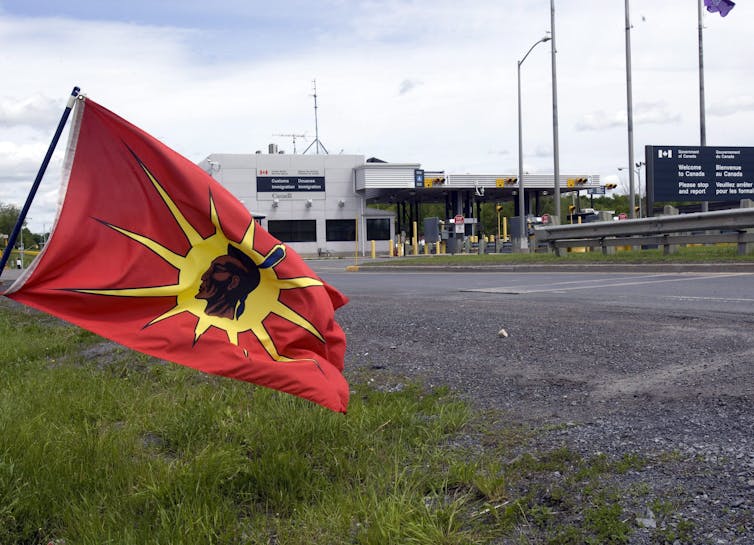On March 29, two households of 4 died though making an attempt to cross the St. Lawrence River from Canada to the U.S. Their bodies ended up identified in Akwesasne Mohawk territory which straddles the Canada-United States border.
Media protection speedily commenced to frame the deadly incident as an situation of illegal human smuggling. Reviews characterized the Akwesasne Mohawk territory as a “smuggling hotspot” and an “suitable spot for trafficking of people and contraband.”
Posts featured exposés on migrants who aided smuggle people across the border as perfectly as Akwesasne persons who assisted in crossings rendered unlawful by U.S. and Canadian governments.
This style of information coverage, which focuses on individuals, lets governments on the two sides of the border to elude responsibility for enacting policies which restrict possibilities to cross borders legally, make irregular crossings extra unsafe and deflect blame onto all those facilitating all those crossings.
But potentially the most obvious omission in media coverage is any significant reflection on what it implies for this tragedy to occur on Indigenous territory.
Indigenous communities and the border
Scholars have drawn attention to historic amnesia when it will come to colonialism and racism in the western media protection of migration. Until this amnesia is tackled, the precarious circumstances, struggling and demise that several migrants fleeing persecution and displacement encounter will proceed.
The Akwesasne tragedy have to be comprehended in the context of colonial record and the imposition of the U.S.-Canada border on Indigenous nations.

(AP Picture/Seth Wenig)
The 1783 Treaty of Paris established a tough preliminary boundary between American settler statements and British settler promises, which ran through the St. Lawrence River, current-day Akwesasne territory and the Wonderful Lakes.
The 1794 Jay’s Treaty codified the inherent rights of Indigenous Peoples to shift freely throughout the border and to have out trade and commerce. Still, in apply, neither colonial govt expended a great deal work to monitor or restrict the motion of people today across the boundary.
But as American and Canadian governments hungrily expanded to the west, the strategy of independence of motion for Indigenous Peoples started to fade away in the deal with of settler colonial aims.
In its place, Indigenous Peoples have been made foreigners in their personal land with mobility and land rights inferior to individuals of European settler migrants. Soon after the Métis-led 1885 North-West Rebellion was put down, Canada executed a routine of racialized migration handle recognized as the Indian move process.
This program manufactured it unlawful for Indigenous people to go away their reserve without having a go issued by an Indian agent for a distinct period and intent. People caught violating go ailments confronted jail time and could be “deported” back to their reserve. The go procedure remained enforced in some locations till the 1940s.
As Historian Benjamin Hoy writes, “[f]rom the extremely outset, Canada and the United States believed that creating a national border on Indigenous lands needed erasing pre-current territorial boundaries.”
Colonial dispossession
Canadian immigration law has traditionally served as a crucial system of colonial dispossession. The 1st Immigration Act of 1869 was created to endorse “a liberal policy for the settlement and colonization of the uncultivated lands”, especially as section of westward expansion.
It did this by actively encouraging white European settlers to come to Canada by granting them protections and rights. These integrated travel assistance, cost-effective homesteads, no removing following arriving and naturalization after 3 years’ home.
On top of that, the 1872 Dominion Lands Act granted big plots of land to any settler who compensated a modest payment and produced sure enhancements on the land. Nonetheless this land was not Canada’s to assert, grant or sell, but fairly belonged to Indigenous nations whose conventional territories were being swept up via armed service violence and unfair treaties.

THE CANADIAN Push/Ryan Remiorz
Undermining Indigenous self-perseverance
Canada has ongoing to assert unilateral sovereignty in immigration when at the same time erasing assorted Indigenous regulations and customs.
This came to a head in the 2006 federal court docket case of Sister Juliana Eligwe, a Nigerian nun in Canada who confronted deportation. Sister Juliana claimed asylum in Canada, expressing that she would face persecution if she returned to Nigeria.
Sister Juliana worked as live-in nanny and housekeeper. She also volunteered with the Sandy Bay Ojibway To start with Country in Manitoba the place she supported youth going through the emotional trauma of dropping friends and loved types to suicide.
In a bid to reduce her deportation, the 1st Nation manufactured Sister Juliana a band member. The Initial Nation’s lawyers argued that Canada’s Immigration and Refugee Protection Act should be read in a way that recognized the inherent appropriate of Indigenous communities to figure out political membership, as well as any member’s proper to enter and remain in Canada.
The court docket turned down that argument, expressing the To start with Country was attempting “to usurp the discretion of the Minister of Citizenship and Immigration by accepting non-people as band members and thus granting them long lasting resident position.”
In the end, Sister Juliana was deported to Nigeria, an additional country deeply affected by the legacies of British colonialism. In siding with the federal federal government, the court docket proficiently took absent the To start with Nation’s correct to make your mind up on its possess membership.
A vital component of the truth of the matter and reconciliation method is for settlers to admit treaty associations with Indigenous communities and their treaty rights to be on this land. It is untenable that immigration plan continues to be untouched by the obligations of reconciliation and decolonization.
To enable avoid more tragedies at the border, Canada ought to make a motivation to reckon with its unfair and colonial background of immigration. 1 of the initial measures is to admit and regard Indigenous sovereignty, laws and treaty relations when it will come to immigration.







